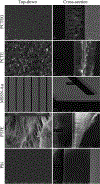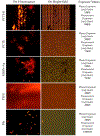Comparative evaluation of filtration and imaging properties of analytical filters for microplastic capture and analysis
- PMID: 37127196
- PMCID: PMC10266694
- DOI: 10.1016/j.chemosphere.2023.138811
Comparative evaluation of filtration and imaging properties of analytical filters for microplastic capture and analysis
Abstract
Pollution by microplastics (MPs) is a growing problem that is now well-recognized, as concerning levels of MPs have been found in drinking water, food, and even human tissues. Given the evolving understanding of their toxicological effects on human health, MPs are an area of concern requiring further study. Consequently, there is a need for greater understanding of the performance characteristics of common MP analytical methods and where possible, for standardizing methods and reporting practices. Here, we report our work comparing filtration and imaging properties of five analytical filters suitable for MP capture and analysis. We compared track-etched polycarbonate with (PCTEG) and without gold coating (PCTE), polytetrafluoroethylene (PTFE), porous silicon (PSi), and gold-coated microslit silicon nitride membranes (MSSN-Au). Four of the filter types had a nominal 1.0 μm cut-off, except for PCTEG which had a 0.8 nominal cut-off. We examined the ultrastructure of each membrane type by electron microscopy to understand how their physical properties influence filtration and imaging performance. We compared clean water filtration rates and timed volume passage for each filter in comparison to its porosity and working surface area. We further compared optical microscopy imaging properties for each filter with model MP samples in both bright-field and fluorescent modes with accompanying Nile Red staining. In terms of absolute and surface area-normalized flow rates, our measurements ranked the filters in order of MSSN-Au > PTFE > PCTE > PCTEG > PSi. Similarly, we found MSSN-Au filters compared favorably in terms of optical microscopy performance. Collectively, these data will aid practitioners when choosing analytical filters for MP surveillance and testing.
Keywords: Analytical methods; Filtration; Microplastics; Optical microscopy.
Copyright © 2023 The Authors. Published by Elsevier Ltd.. All rights reserved.
Conflict of interest statement
Declaration of competing interest The authors declare the following financial interests/personal relationships which may be considered as potential competing interests: JR is a co-founder and equity holder of SiMPore Inc.
Figures


References
-
- Ragusa A, Svelato A, Santacroce C, Catalano P, Notarstefano V, Carnevali O, Papa F, Rongioletti MCA, Baiocco F, Draghi S. Plasticenta: First evidence of microplastics in human placenta. Environment International.146:106274. - PubMed
-
- Schwabl P, Köppel S, Königshofer P, Bucsics T, Trauner M, Reiberger T, Liebmann B. Detection of various microplastics in human stool: a prospective case series. Annals of internal medicine. 2019;171(7):453–7. - PubMed
MeSH terms
Substances
Grants and funding
LinkOut - more resources
Full Text Sources
Medical

